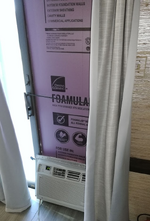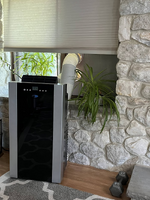IMA SOL MAN
Flashlight Enthusiast
Painting your house exterior white can help. I realize that with some HOA's that may not be possible, but choose as light a color as you can will help some.
 Help Support Candle Power Flashlight Forum
Help Support Candle Power Flashlight Forum
How much $ you got? Look up Ambition Strikes on YouTube. Riley and Courtney spent $50K on a solar and battery system big enough it took two solid weeks of overcast North Idaho weather to run out of juice. They also have a military surplus diesel generator and this year added more PV panels as an awning over their second floor deck, charging a battery stack in the first floor shop. The huge PV array is mounted to a shipping container up the hill from their "Barndominium".Act now, and they will throw in a Super Tactical Arctic 3 Mile flashlight for just a shipping and handling fee.
Interesting ideas here. Exterior blinds sound great but where we live, the winds can be quite distracting. Any strategies to minimize slumber noise from wind?
Researching mini split heat pumps on diysolarforum; still too much unknown for our application. Being off grid, we only have so much electrical oomph. Really needing to not exceed ~1000 Watts though it seems possible to run some units at a lower level? But would it then be strong enough for some comfort in our small abode?


My wife pours some milk in an insulated cup for coffee. When done she puts it back in the fridge.Sounds like the house I grew up in.
Same thing with the refrigerator. Leave the door open for as short a period of time as possible. One may think that the open door cools the room, slightly, but the compressor generates more heat recooling the inside of the fridge.
I keep the milk for my morning coffee in the door shelf, near the open side of the door. This way I can open the door part way, only inches, to grab the container. If it was stored near the hinge side of the door, I'd have to open the door way more open to reach for it.
Thanks chance.SWEET upgrade!
That's the temps without running the central AC. I don't turn it on until it after sundown at the earliest. It's actually 10pm now and I haven't run it yet.
I overestimated the diameter of the Patton fan; I measured ~18" blade diameter. It seems bigger than that when carrying it!
The fan wattages you state seem pretty high; is that what you've measured? I'm running them all on "low" anyway so it won't be the full-blast rating that's on the box or sticker or something.
Maybe 300 watts for all three fans together. And that ain't much compared to the computer and monitor, and my own 6'3" body radiating 100W all on its own, and the massive thermal load the sun put on the building during the day.
...
I cleaned the condenser coil of the central AC unit, that also made a significant improvement.
...
With fans I'm ok up to say 80 deg inside, but sleeping at night is the problem. I can't get to sleep if I've got a fan blowing directly on me; it's like having someone randomly poke me as I'm trying to sleep (because of the irregular air flow hitting me).
I aim the fan up at the ceiling so that there is just a slight air current drifting over me and that works. But if it's 80 or higher in the bedroom then that's still not enough air flow to be comfortable.
It'd help if the mattress was water-cooled or something. Lying on a mattress is HOT when the weather is warm and sticky!
Pricey, but the best desktop fan I've ever had. The 'turbo' is really high, but the real gem is the whisper low setting. Read the reviews.
View attachment 45628
lot of useful stuff here, I'll ad my two cents, because nowadays we get 42 C ( 108 F ) summer heat here, which is measured in shade over a grassy area... this also means walking the dog when the sun is out is impossible, as the concrete usually heats up to temperatures that will cook eggs and also poor doggos paws.
so what I figured to keep your home cool is to disallow heat to access it, and remove heat if it did. from what I gathered in the recent years is
1, do not allow the sun to touch your house. this has the huge caveat of having to have control of the house, which is, if you live in an apartment, is not possible. but, if you live in a detached house, you need to make sure that the sun doesn't reach the roof and walls, most useful is trees, that block the sun in the summer time, but the leaves will fall in autumn so you'll have some heating from the sun in winter. you can also use tarps, mylar or anything the sort, just mind where you reflect the heat and light, you don't wanna boil your neighbor.
2, if the light touches the house you need good insulation, so it won't seep heat into the structure itself. I don't know how well north American house structures can store heat, as they are made out of wood ( mostly, afaik ) but here we have brick walls, so you need to have thick insulation on the outside of the structure to avoid heat going in ( or out at wintertime... ).
3, block sunshine through the windows from the outside . we use roller shutters, but anything that blocks the sun but won't transfer heat into the window itself should be okay
4, if the heat already reached the inside of your home, try to manage the perceived temperature, move the air around, and try to keep the air as dry as you can, if you've been to the desert you'll recall that 38C/100F in the basically zero humidity is perfectly manageable, you only need to remember to drink a LOT. also try to keep the heat sources inside the house to a minimum, so try to use the least amount of dryer, stove, tv, pc, basically anything that generates a lot of heat.
5, Move the air! Opening the windows at night can be useless if there is no draft , so always pay careful attention to actually have the air move through the home, if your home has draft naturally, great, but you might want to place a high throughput fan in one window pushing air in, and in another room sucking air out. this has helped me tremendously at summer night times when air just basically stagnated inside, so even though it was colder outside, it didn't get any colder inside .
+1: if it can applied, running a drip irrigation system close your windows can allow the grass to be cool, hence the air entering through your windows will be cooler, but this assumes basically wasting water for a bit of relief from the heat, so not ideal
as other mentioned, closing your dwelling to the outside during the day, and opening everything at night is a good idea, but as also others mentioned, sometimes even the evening temperatures are way too high, so this might not work at all...
so what can you do if you already have hot air inside? from worst to best, here is my experience:
- swamp cooler: basically just blowing air through a wet piece of material, it WILL cool down the air a tiny bit, and also it will even filter the air, so great for catching pollen and dust, however... Mold. It will increase humidity, which will eventually decrease your comfort , and the water and the filter - or the material you blow through air - will develop mold, so you'll need to manage that and keep a close eye on what you're breathing in
- simple fans: great when you just need a bit of cooler feeling, but when the temperature reaches a certain point, you're just sitting in an air circulated oven, it feels much worse to have hot air blown at you
- portable AC: fairly OK, but most of them literally sucks, meaning it will suck air out of the room it's placed in, there are countless information on them why they are not the greatest solution, but sometimes that's your only way to introduce cold air into the area you're in
- window AC: one of the best available options, but can get fiddly, also here the price is the same as a split AC unit, so if possible, a split version is favourable
- split/central AC: the best bang for buck ratio, only caveat I found that it can dry the air too much, leaving you open to more respiratory diseases , but with some simple air humidification ( not sure that's a word ) you can manage just fine, also you can use it to heat your home come winter time
- heat exchanger cooling: fairly complex, you need two drilled wells, you bring water up from one, into the heat exchanger, blow cool air inside, dump heated water into the other well. requires very little maintenance, consumes only the fraction of the power of an AC, and can supply 17 C / 62 F cold air throughout the summer for cheap. the issue with this is obvious, you need two wells, piping to and from your heat exchanger, a heat exchanger ( if you're heating isn't connected to one ) , but if possible, this is one of the best solutions you can get long term, you can use it in the winter as well to help out a bit for your heating needs if designed properly
- geothermic air conditioning: same as the previous mostly, but instead of wells you have a closed loop of liquid pulling the heat from the house and dumping it underground, uses a tiny amount of power comparatively, reliable and sustainable, but the initial cost is just astonishing... or at least here. you need to place the pipes deep down the ground, for that you need to move the earth quite a bit, and you need very high quality pipes, that can lay in the ground for years and years without leaking or bursting. this is basically the going down in to your cellar to cool off, just bringing the cellar up to the attic as well, it's great in all aspects, other than the price
one thing I've been messing around recent days is an actual 'personal AC', which is basically running icy water through a coolant radiator and pushing the cold air at you, like so:
I'm still waiting for some parts, but I'll report back how it goes
Mini splits have their place. I abandoned ducted cooling a decade ago and installed 7 units indoors and three compressors outdoors. Ducts were mostly outside the envelope which is a very bad idea, yet most or many homes are built or retrofitted that way. For me, a lot more upkeep (cleaning) is needed. With multiple units, more failure points are added. One nice thing with variable speed compressor mini splits is that there is virtually no start-up surge. If I put a clip-on ammeter on mine and fire them up, they sit and think about it for a few moments with the number barely changing. Then the current ramps up at a leisurely pace, peaks at maybe an amp above where it settles in to run what indoor units are turned on. It is great for using a small portable genset for backup. For small PV with a correspondingly small battery/inverter capacity, I am sure it would be an advantage as well. They throttle back to about 30% of total capacity before they start to cycle and run most efficiently at steady, partial load. Most of this is true for bigger ducted central units as well except that you can obviously pare back load further by choosing which room or rooms to cool in a power outage.Researching mini split heat pumps on diysolarforum; still too much unknown for our application. Being off grid, we only have so much electrical oomph. Really needing to not exceed ~1000 Watts though it seems possible to run some units at a lower level? But would it then be strong enough for some comfort in our small abode?
Careful, power attic fans are often, if not almost always, a bad idea. First off, there are generally a lot of leaks between the living space and the attic space. Power vents will then cool the attic by sucking conditioned air out of the living space. That is not productive. Second, you should have enough ventilation properly placed to cool the attic passively. Third, heat gain from the roof is mostly from radiated energy from the roof deck to the attic floor so no amount of moving air is going to help much with that. If you have HVAC in the attic, you may be better off insulating the roof deck and sealing the attic. For some time, radiant barriers suspended in attics were popular. They work until they get dirty.Installed a thermostatically-controlled power vent fan for attic to help with the ridge vents. Dropped attic temp ~20F. Still HOT up there. Significant as the HVAC is in the attic.
For cooking, induction hobs are generally a lot more efficient at getting the food hot rather then the room. That said, they are a little overrated compared to a big pot on a resistance coil at moderate heat setting. That is pretty efficient. But if you are bringing up a pot to boil quickly, induction is king.Keep the insulated drapes shut. Do not use the oven. Cut back on the use of hot water (example, wash laundry with cold water only). Hang wet laundry outside to dry rather than use the dryer. Cook with the microwave oven instead of the stove top. Change or clean the AC filter(s). Run fans in rooms people are in. Spend time in the basement as it is usually the coolest area in the house. Limit opening the doors as much as possible. Put off testing flamethrower flashlights until after dark when it is cooler.
I would be very surprised if some areas where swamp coolers were popular are not now falling away either due to prohibition in building codes or by the expense of ever scarcer water. I lived in Tucson for three years and I agree with J-L D. for comfort except for Monsoon season when humidity can reach a disagreeable 30% and the swamp coolers don't work very well.In my turf, I much prefer those to air conditioners.